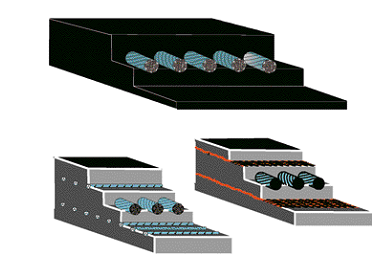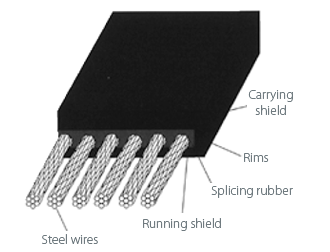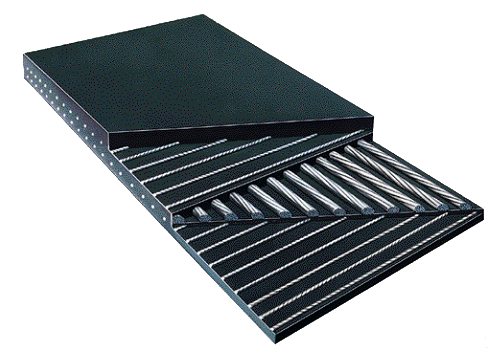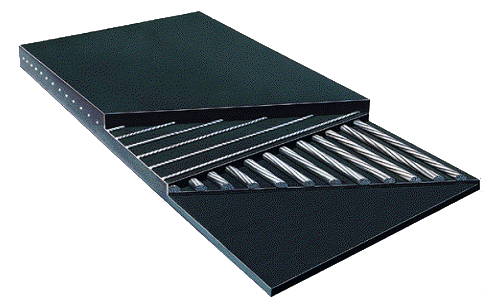STEEL CORD BELTS
Belt cross-section

1) Steel cord belts are used in the following cases:
- severe operating conditions;
- high output;
- long installations and steep inclination;
- high resistance of the belt to breaking.
- possibility to use belts with high resistance to breaking (ST 7000 N/m);
- low elongation, making it possible to use the long conveyors with reduced tensioning path;
- operation safety and long service life;
- good lateral flexibility allows the use of large angles of the trough;
- small diameter idlers can be used;
- durability and service life of the splices similar to the operating period of the belt.
Belt structure

Belt structure:
Shields: excellent resistance to abrasion, aging and UV rays.
Adhesive rubber: Adhesion to galvanized wires and shields: excellent penetration of rubber, high shear rate, resistance to aging.
Transverse reinforcement: depending on the application – with or without transverse fabric or metal breaker/weft.
Availability:
- width from 600 mm to 2000 mm;
- durability from 500 N/mm to 4000 N/mm;
- type series 4+3, 6+3.
2) Steel cord belts with metal transverse reinforcements (2 wefts)
Belt cross-section

Belt structure:
These belts are manufactured with two types of the core (carcass wires and weft wires): The core with elastic wires of the M type carcass (4x7 structure), resistant to strong impacts, particularly suitable for:
- conveyors with small diameter idlers;
- curved routes of the conveyors with small radii;
- severe operating conditions;
- frequent stops and starts.
- excellent wire/rubber adhesion;
- resistance to repeated impacts;
- resistance to penetration of moisture into the wires;
- ability to discard foreign matter;
- reduction of longitudinal cuts and tears;
- possibility to completely use up the shields;
- ability to wind onto small diameter idlers;
- ability to take small diameter crests;
- durable splices;
- easy repairs in emergency situations.
- long service life of the belt;
- cost-effective maintenance;
- improved stability;
- safe usage;
- quick repairs;
- improved production performance.
- width from 600 mm to 2000 mm;
- durability from 500 N/mm to 4000 N/mm;
- type series 4+3, 6+3.
3) Steel cord belts with metal transverse reinforcements (1 weft)
Belt cross-section

Belt structure:
The belt consists of a combination of two layers of wires embedded in rubber. The core contains:
- one layer of ropes running toward the carcass;
- one layer of ropes running toward the weft.
Main advantages:
- long service life of the belt;
- cost-effective maintenance;
- improved stability;
- safe usage;
- quick repairs;
- improved production performance.
- width from 600 mm to 2000 mm;
- durability from 500 N/mm to 4000 N/mm;
- type series 4+3, 6+3.










